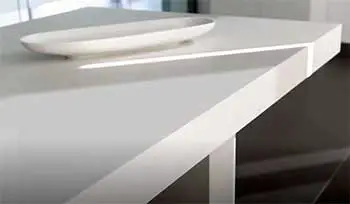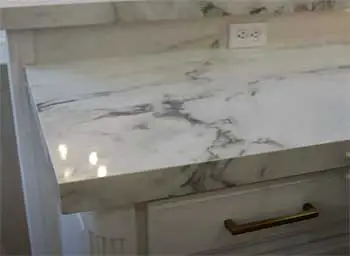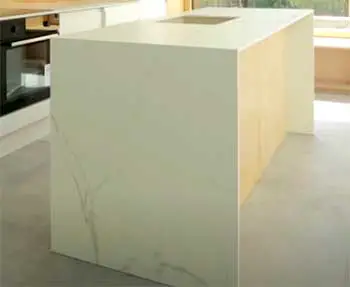When it comes time to remodel your kitchen or build a new one from scratch, choosing the right countertop material is one of the most important decisions you’ll make. The countertops are the workhorse of the kitchen – the surface where you’ll prepare countless meals over the years.
Between popular options like granite, quartz, laminate, and solid surface, two of the most coveted materials are Neolith and porcelain.
But understanding the key differences between them is essential before deciding which is better suited for your needs and budget.
At A Glance Comparison
| Feature | Neolith | Porcelain |
| Composition | Sintered stone (compacted natural materials and pigments) | Clay and other natural materials |
| Durability | Extremely durable and scratch resistant | Durable but can chip or crack |
| Heat Resistance | High heat resistance | Low to moderate heat resistance |
| Stain Resistance | Excellent stain resistance | Very good stain resistance |
| Maintenance | Low maintenance | Low maintenance |
| Cost | $$$$ (premium) | $$ (moderate) |
| Styles/Colors | Large range of colors and styles | Many color and style options |
| Edges | Can be polished or left natural | Can be finished in various ways |
| Customization | Highly customizable in size and finish | Moderate customization options |
| Installation | Should be installed by a professional | Can be DIYed but pro install often best |
| Environment | Not recyclable | Recyclable |
Key Differences Between Neolith and Porcelain
While Neolith and porcelain share some similar characteristics, several important factors set them apart. Understanding these key differences will help guide your decision.
- Composition and Manufacturing

Neolith has a very different composition and manufacturing process from porcelain.
Neolith starts with natural stone materials like granite, quartz, and clay that are ground into a powder.
Pigments are added for color and then the powder is compacted at high pressures and baked at 700 ̊C into slabs.
Porcelain is made only from clay and other natural materials that are pressed and fired at even higher temperatures between 1200-1400 ̊C. This vitrifies the clay into a glassy, impervious finish.
Also Read: Differences Between Butcher Block And Quartz Countertops.
- Hardness and Durability
Neolith is harder and more scratch-resistant than porcelain. On the Mohs scale of mineral hardness, Neolith ranks at about 7 while porcelain is slightly lower at 6. Neolith’s extreme density and low porosity give it unmatched durability.
Porcelain is still very durable but is more prone to chipping from impacts. It can also develop cracks over time with temperature fluctuations as the material expands and contracts.
- Heat Tolerance
Neolith has excellent heat tolerance thanks to its hardness. Hot pots and pans can be placed directly on the surface without worry. Porcelain has lower heat resistance, so trivets or hot pads must be used. Prolonged exposure to extreme heat can damage porcelain.
- Stain Resistance
The non-porous nature of Neolith makes it virtually impenetrable to stains when properly sealed. Porcelain is also highly stain resistant, but some materials like wine, oil and grease may absorb slightly into the surface over time. This requires more careful cleaning.
- Styles and Patterns
Neolith offers unmatched realism in mimicking exotic natural stones and marbles with dramatic veining, colors and patterns. Porcelain is limited in reproducing the most elaborate designs but still offers a diverse range of attractive styles.
- Costs

As an elite engineered stone, Neolith sits at the highest price point, comparable to premium natural stones.
Porcelain provides significant cost savings of 30% or more versus Neolith. This makes porcelain accessible to more budgets.
Let me know if you would like me to expand on any of these differences in more detail.
I’m happy to provide any additional information that would help compare these two countertop materials.
Now let’s dive into the details on each material to help inform your decision.
Also Read: Comparison of HI-MACS And Quartz Countertops.
Overview of Neolith
Neolith is a brand of sintered stone countertops, a relatively new engineered stone product that has grown in popularity over the last decade. Sintered stone starts as natural materials like granite, quartz, clay, silica and industrial byproducts that are ground into a powder.
Pigments are added to achieve different colors and patterns.
The powder mixture is then compacted at extremely high pressures and baked at temperatures over 700 ̊C. This forces the materials to fuse together and crystallize, forming a remarkably hard, non-porous slab.
The resulting product is visually striking and mimics the look of natural stone. Neolith offers slabs in a wide range of colors, styles, finishes and thicknesses.
Pros of Neolith

- Extremely durable – With high density and low porosity, Neolith resists scratches, stains, impacts and heat better than most surfaces. It’s nearly impervious when properly sealed.
- Visually stunning – From exotic marble looks to bold colors and patterns, Neolith offers unmatched beauty and realism that makes a dramatic design statement.
- Low maintenance – Neolith requires very little maintenance beyond cleaning with soap and water. It does not need regular sealing or polishing.
- Customizable aesthetic – Neolith offers many sizes, edges, finishes, colors and designs for a completely customized look. Virtually any kitchen can find a suitable style.
- Long lifespan – With durability measured in decades, Neolith countertops will retain their beauty and function for years of heavy usage. They do not need replacement nearly as often as most materials.
Cons of Neolith
- Expensive – Being an engineered stone made of premium materials, Neolith sits at the highest tier of pricing, comparable to high-end natural stone. Installation also pushes costs up.
- Limited supply – Due to its relatively new and patented production process, Neolith availability is constrained compared to more common materials. Lead times can be 6-8 weeks for fabrication and installation.
- Not recyclable – There are currently no recycling options for Neolith, so old countertops must be landfilled. The sintering process prevents reusing the raw stone materials.
- Seam visibility – The intense colors and patterns of Neolith can make seams between slabs more visible if not done perfectly. Good fabricators minimize the seams.
- Can crack if overloaded – Although resistant to cracks from regular use, sitting or standing on Neolith can cause hairline cracks or fissures because its hardness makes it brittle under extreme loads.
Overview of Porcelain

Porcelain countertops provide a classic, timeless look. Porcelain is made from clay and other natural materials that are pressed and fired at ultra-high temperatures – typically between 1200 ̊C and 1400 ̊C.
The intense heat fuses and vitrifies the materials, forming a smooth, glassy surface that is harder and less porous than natural stone.
Modern porcelain comes in slabs with a wide variety of styles mimicking marble, concrete, natural stone and more. It offers a durable surface that resembles higher-end materials at a more affordable price point.
Installation options range from DIY kits to professional fabrication and installation.
Pros of Porcelain
- Very durable – Porcelain rates just below Neolith on durability tests. The glassy finish resists scratches, stains and heat. Porcelain lasts for decades with proper care.
- Affordable – Porcelain counters offer significant cost savings over natural stone and engineered materials. The price point makes high-end looks achievable for more budgets.
- Easy maintenance – Porcelain needs little more than cleaning with soap and water. Annual sealing is recommended but not required.
- Wide range of styles – From sleek moderns looks to convincing stone and marble, porcelain comes in countless colors, patterns and finishes to suit any kitchen aesthetic.
- Easy DIY install – Porcelain pieces can be directly bonded to existing countertops in a DIY project, avoiding demolition. Kits include adhesives and instructions.
- Sustainable and recyclable – Since porcelain is a fired clay product, it can be recycled, reused and repurposed, avoiding landfill waste. New counters can contain recycled content.
Cons of Porcelain
- Prone to cracks and chips – While durable for everyday use, porcelain can chip from impacts. Cracks can form over time from extreme temperature changes. Porcelain requires gentle use.
- Low to moderate heat resistance – Prolonged direct heat exposure can damage porcelain. Trivets and hot pads should be used to protect the surface.
- Seam visibility – Like other solid materials, the seams between porcelain slabs may be noticeable. Color variations can further accentuate the seams.
- Professional install recommended – Although DIY installation is possible for some porcelain products, professional fabrication and installation is recommended to ensure proper seam placement and prevent future issues. This drives up costs.
- Limitations in some designs – Intricate natural stone patterns and dramatic color variations can be difficult to reproduce in porcelain within a consistent slab. Options are more limited.
- Surface abrasions – Porcelain can become abraded over many years of use, gradually dulling the surface. Re-firing or polishing may become necessary to restore the glassy finish.
Key Considerations
When comparing Neolith and porcelain head-to-head, the major differences come down to durability, heat resistance, stain resistance, maintenance, cost, and customization options.
For sheer indestructibility against scratches, stains and heat, Neolith is unmatched. The dazzling designer colors and elaborate veining take kitchen design to the highest level. But you pay a premium price for these benefits.
Porcelain offers excellent durability and style at a more affordable cost. The range of colors and patterns allow for high-end looks without maxing out the budget. But porcelain requires more care around impacts and heat exposure.
For DIY projects, porcelain tile kits are easier to self-install. Neolith requires professional measurements, fabrication, transportation and seamless installation to deliver a flawless finished product. This further adds to the total cost.
Your personal priorities for budget, kitchen usage, design aesthetic and sustainability will determine whether durable Neolith or affordable porcelain makes the most sense for your next kitchen countertop project.
Carefully weighing the pros and cons of each material will lead you to the ideal long-term investment.
Frequently Asked Questions (FAQ)
No, Neolith and porcelain are different materials and manufacturing processes. Porcelain is made from clay while Neolith uses natural stone materials and pigments that are compacted at high pressure and temperature through a sintering process. While they share some similarities, Neolith is denser, harder and more resistant to damage.
The main downsides of Neolith are the high cost, limited supply and availability, lack of recyclability, and visibility of seams between slabs. Being a premium engineered stone, it sits at the top price tier. Lead times can also be lengthy. There are also no recycling options currently, so old Neolith counters must be landfilled.
Sintered stone like Neolith is better than porcelain in durability, scratch resistance, stain resistance and heat resistance. The sintering process makes it incredibly dense and impermeable. However, porcelain costs significantly less while still providing excellent durability that satisfies most homeowners. Porcelain also offers more eco-friendly sustainability.
For homeowners who prioritize unmatched performance, luxury aesthetics and cutting-edge style, Neolith is worth the premium investment. It provides one of the highest levels of beauty and durability available. But those on tight budgets or seeking a more eco-friendly material may settle for porcelain or quartz. Neolith is worth it only if its benefits align with your priorities.
Final Thoughts
When designing your dream kitchen, there’s no universally superior choice between Neolith and porcelain. This guide provides detailed facts to weigh the pros and cons most important for your needs.
Both offer incredible durability, style and longevity that will keep you satisfied for decades. Consult a knowledgeable kitchen designer to discern whether elite Neolith or affordable porcelain makes the best sense for both your lifestyle and budget.
In a kitchen you’ll use daily, you want confidence you made the perfect counters decision.


Can Neolith samples be seen in Lowes, Home Depot and other convenient outlets?